
India 1988-89

India 1988-89
Page 3
 Tom,
Oran, and I traveled by bus to the hill station of Mussoorie, the Queen of
Hills. Hill stations like this are frequented by visitors in the
summer months as a way of escaping the intense heat of the plains.
However, we went up here during December, and it was quite cold. Tom,
Oran, and I traveled by bus to the hill station of Mussoorie, the Queen of
Hills. Hill stations like this are frequented by visitors in the
summer months as a way of escaping the intense heat of the plains.
However, we went up here during December, and it was quite cold. |
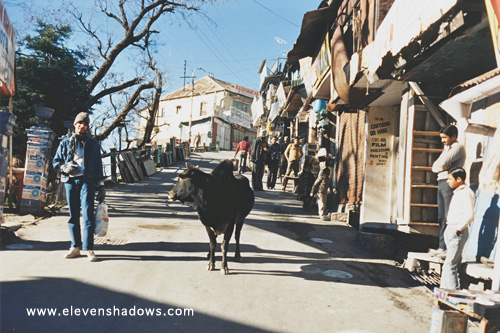 Tom
and his friend walk the streets of Mussoorie, located in the Himalayan
foothills north of Dehradun. Tom
and his friend walk the streets of Mussoorie, located in the Himalayan
foothills north of Dehradun. |
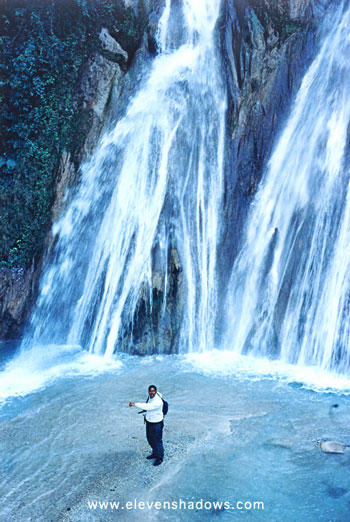 We
walked to Kempty Falls, located 15km from Mussoorie. The falls plummets from
4500 ft., eventually splitting into five cascades. We
walked to Kempty Falls, located 15km from Mussoorie. The falls plummets from
4500 ft., eventually splitting into five cascades.
Oran checks out the base of the falls. |
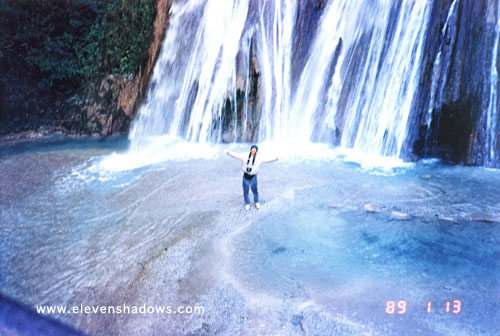 ...and
so do I (photo: Tom). ...and
so do I (photo: Tom). |
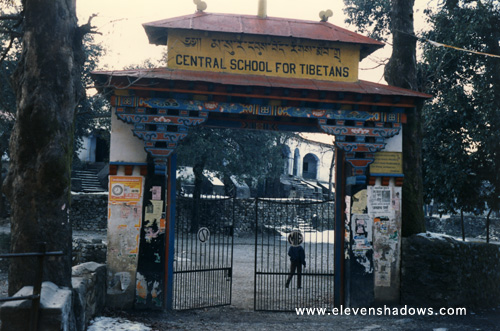 In
1959, some 100,000 Tibetans fled the Chinese invasion of Tibet, eventually
establishing their Tibetan Government in Exile in Mussoorie, eventually
moving it to Dharamsala in Himachal Pradesh. In
1959, some 100,000 Tibetans fled the Chinese invasion of Tibet, eventually
establishing their Tibetan Government in Exile in Mussoorie, eventually
moving it to Dharamsala in Himachal Pradesh.
The Central School for Tibetans was established in Musssoorie in 1960. There are now about 5,000 Tibetans who live in Mussoorie. Although I knew that Tibet had been invaded and occupied by China, this was the first time I had met Tibetans.
|
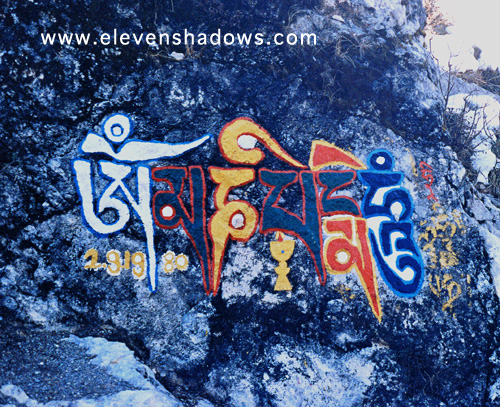 Tibetan
"graffiti" on a hillside in Mussoorie, en route to the Tibetan temple. Tibetan
"graffiti" on a hillside in Mussoorie, en route to the Tibetan temple. |
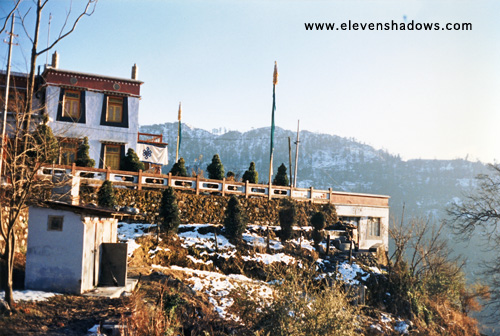 Tibetan
Temple in Mussoorie. Tibetan
Temple in Mussoorie.
I had been fascinated in Tibetan culture since a 1986 trip to China, and meeting Tibetan monks and hearing some of their stories stoked the flames of curiosity even further. Their stories, always infused with compassion, moved me. Several years later, I began composing and writing music that wove some of these stories and feelings, which eventually became Sangsara. I also became active with Los Angeles Friends of Tibet and began editing The Tibet Connection radio show at my studio, Blueberry Buddha Recording Studios. |
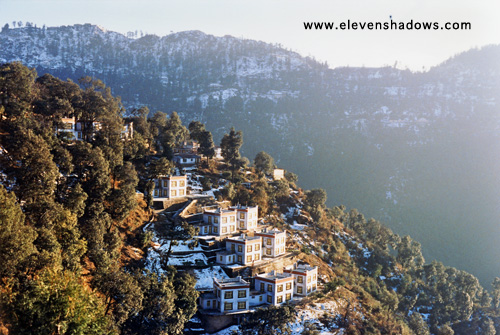 Tibetan
settlements cling to the Himalayan hillsides in Mussoorie. Tibetan
settlements cling to the Himalayan hillsides in Mussoorie. |
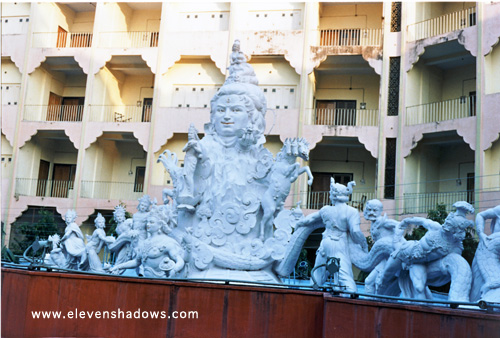 After
several days, we descended from the foothills of the Himalayas to the mouth
of the sacred Ganges River, Haridwar. In Hindi, Haridwar stands for
Gateway to God, with 'hari' meaning god and 'dwar' meaning gate. Haridwar is
regarded as one of the seven holiest places to Hindus, as the devas are said
to have left their footprints there. After
several days, we descended from the foothills of the Himalayas to the mouth
of the sacred Ganges River, Haridwar. In Hindi, Haridwar stands for
Gateway to God, with 'hari' meaning god and 'dwar' meaning gate. Haridwar is
regarded as one of the seven holiest places to Hindus, as the devas are said
to have left their footprints there.We arrived very late at night in Haridwar, and had difficulty finding a place to stay. Tom knocked on the door of Jai Shri Ashram (Shri Jai Ram?), asking them if we could stay. The person said that the ashram was only for Indian residents. However, Tom somehow managed to convince them that the three of us - including a Chinese and black guy, were living in India. Perhaps out of sheer exasperation, the ashram finally capitulated and said we could sleep there. This is the view inside the ashram. |
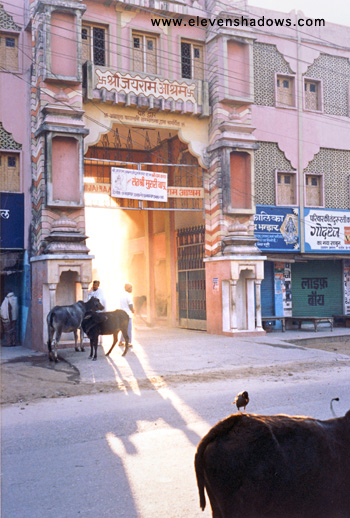 The
entrance to the ashram where we stayed. The
entrance to the ashram where we stayed.Haridwar is one among the four sites where drops of the elixir of immortality Amrita accidentally spilled over from the pitcher (or Kumbha), in which it was being carried away by the celestial bird Garuda, the vehicle of Vishnu. These four spots -- Ujjain, Haridwar, Nasik, and Allahabad -- have today become places of prominence where the Kumbha Mela is celebrated. This celebration occurs every 12 years. Here, millions of pilgrims, devotees, and tourists congregate from all over the world to celebrate this celestial event and perform ritualistic bathing on the banks of the Ganges River. |
 Tom
had to go back to New Delhi to attend a family function, and Oran went with
him. Tom
had to go back to New Delhi to attend a family function, and Oran went with
him.
I decided to stay in Haridwar for a couple of days longer. I was quite enamored with the city and wanted to spend more time there. I met this man, Bhagat, a devotee of Shri Guru Nanak, helping to feed the hungry at Ann Chhetter Bhandar by Gau Ghat in Haridwar. We talked for a while, and he showed me his home, a modest room with a bed on the floor, some blankets, and an altar. I remembered thinking how interesting it was that this man was devoting his life to feeding the hungry when he himself had so few possessions. He gave me his card. On it was a phone number for the organization in Haridwar - three numerals only. |
 The
faithful bathing in the sacred waters of the Ganges River in Haridwar, their
saris and clothes laid out on the ghat to dry in the January sun. The
faithful bathing in the sacred waters of the Ganges River in Haridwar, their
saris and clothes laid out on the ghat to dry in the January sun. |
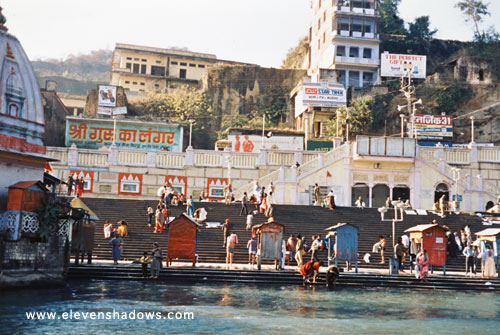 Hindus
brave the cold waters of the Ganges, flowing from the heights of the
Himalayas, at the gate of the Ganges, Haridwar. Hindus
brave the cold waters of the Ganges, flowing from the heights of the
Himalayas, at the gate of the Ganges, Haridwar. |
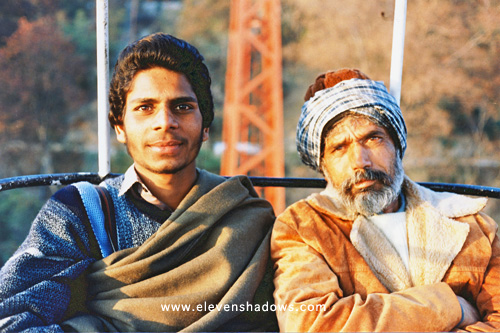 I
took a tram up to the Mansa Devi Temple in Haridwar. I
took a tram up to the Mansa Devi Temple in Haridwar.The temple is dedicated to Mansa Devi, an incarnation of Goddess of power, Durga. The temple is perched on a hilltop, called Bilwa hill, and is the most visited temple in Haridwar. I met these pilgrims on my way up. |
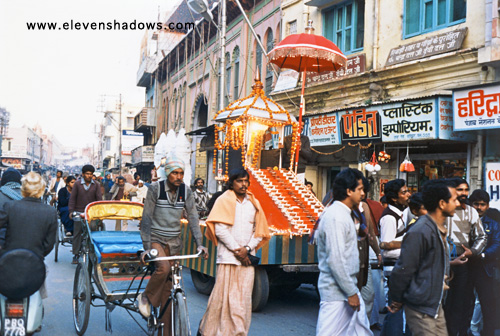 The
streets of Haridwar. The
streets of Haridwar. |
India 1988-1989
Page 3